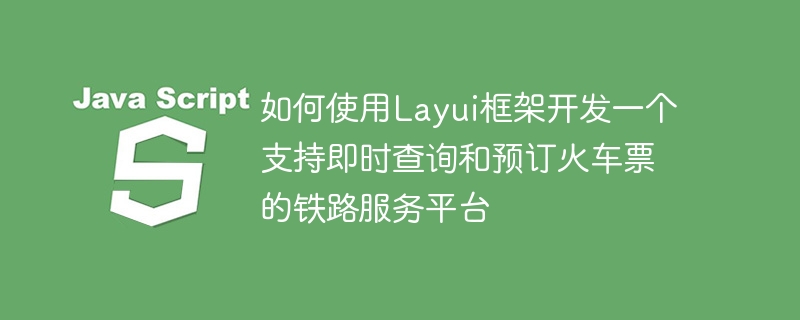Home >Web Front-end >JS Tutorial >How to use the Layui framework to develop a railway service platform that supports instant query and booking of train tickets
How to use the Layui framework to develop a railway service platform that supports instant query and booking of train tickets
- WBOYWBOYWBOYWBOYWBOYWBOYWBOYWBOYWBOYWBOYWBOYWBOYWBOriginal
- 2023-10-24 12:15:201414browse

How to use the Layui framework to develop a railway service platform that supports instant query and booking of train tickets
With the continuous development of the Internet, people's lives are becoming more and more convenient. , more and more people choose to buy tickets online for travel. As one of the most commonly used means of transportation, train tickets are increasingly purchased through online platforms. This article will introduce how to use the Layui framework to develop a railway service platform that supports instant query and booking of train tickets, and provide specific code examples.
Layui is a simple, easy-to-use, efficient and beautiful front-end UI framework. It provides a rich set of components and templates that can help us quickly build a beautiful interface. The core function of the railway service platform is instant query and booking of train tickets, so we need to use the Layui framework to implement the following modules:
- Login module
Users can log in through their account number and password . In the front-end interface design, we can use Layui's form components and verification modules to implement account and password input and verification, and use ajax to send and receive login requests. - Query module
Users can query qualified train tickets by entering the departure place, destination and date. In the front-end interface design, we can set up input boxes, date pickers and query buttons, use ajax to send query requests, and use table components to display query results. - Booking module
After the user selects a train ticket in the query results, he can make a reservation. In the front-end interface design, we can use Layui's pop-up component to display ticket information and send booking requests through ajax.
The following is a sample code for a railway service platform developed using the Layui framework:
HTML code:
<!DOCTYPE html>
<html>
<head>
<meta charset="utf-8">
<link rel="stylesheet" href="layui/css/layui.css">
<script src="layui/layui.js"></script>
<title>铁路服务平台</title>
</head>
<body>
<div class="layui-container">
<form class="layui-form">
<div class="layui-form-item">
<label class="layui-form-label">出发地</label>
<div class="layui-input-block">
<input type="text" name="from" required lay-verify="required" placeholder="请输入出发地" autocomplete="off" class="layui-input">
</div>
</div>
<div class="layui-form-item">
<label class="layui-form-label">目的地</label>
<div class="layui-input-block">
<input type="text" name="to" required lay-verify="required" placeholder="请输入目的地" autocomplete="off" class="layui-input">
</div>
</div>
<div class="layui-form-item">
<label class="layui-form-label">日期</label>
<div class="layui-input-block">
<input type="text" name="date" id="date" required lay-verify="required" placeholder="请选择日期" autocomplete="off" class="layui-input">
</div>
</div>
<div class="layui-form-item">
<div class="layui-input-block">
<button class="layui-btn" lay-submit lay-filter="search">查询</button>
</div>
</div>
</form>
<table class="layui-table" lay-filter="result"></table>
</div>
<script>
layui.use(['form', 'laydate', 'table'], function(){
var form = layui.form;
var laydate = layui.laydate;
var table = layui.table;
// 日期选择器初始化
laydate.render({
elem: '#date'
});
// 监听查询按钮
form.on('submit(search)', function(data){
// 发送ajax请求获取查询结果,并渲染到表格中
table.render({
elem: '#result',
url: 'http://example.com/query',
method: 'post',
request: {
pageName: 'pageNum',
limitName: 'pageSize'
},
where: data.field,
page: true,
cols: [[
{field: 'trainNo', title: '车次'},
{field: 'from', title: '出发地'},
{field: 'to', title: '目的地'},
{field: 'date', title: '日期'},
{field: 'price', title: '票价'},
{field: 'operation', title: '操作', toolbar: '#toolbar'}
]]
});
return false;
});
});
</script>
</body>
</html>The above code is only an example and may not be used in actual development Back-end code needs to be written to implement functions such as login, query, and reservation, and to interact with the front-end data. At the same time, in order to ensure the security and stability of the system, user identity authentication, parameter verification, exception handling, etc. are also required.
I hope this article can help you understand how to use the Layui framework to develop a railway service platform that supports instant query and booking of train tickets. If you have any questions, please feel free to communicate and discuss.
The above is the detailed content of How to use the Layui framework to develop a railway service platform that supports instant query and booking of train tickets. For more information, please follow other related articles on the PHP Chinese website!

